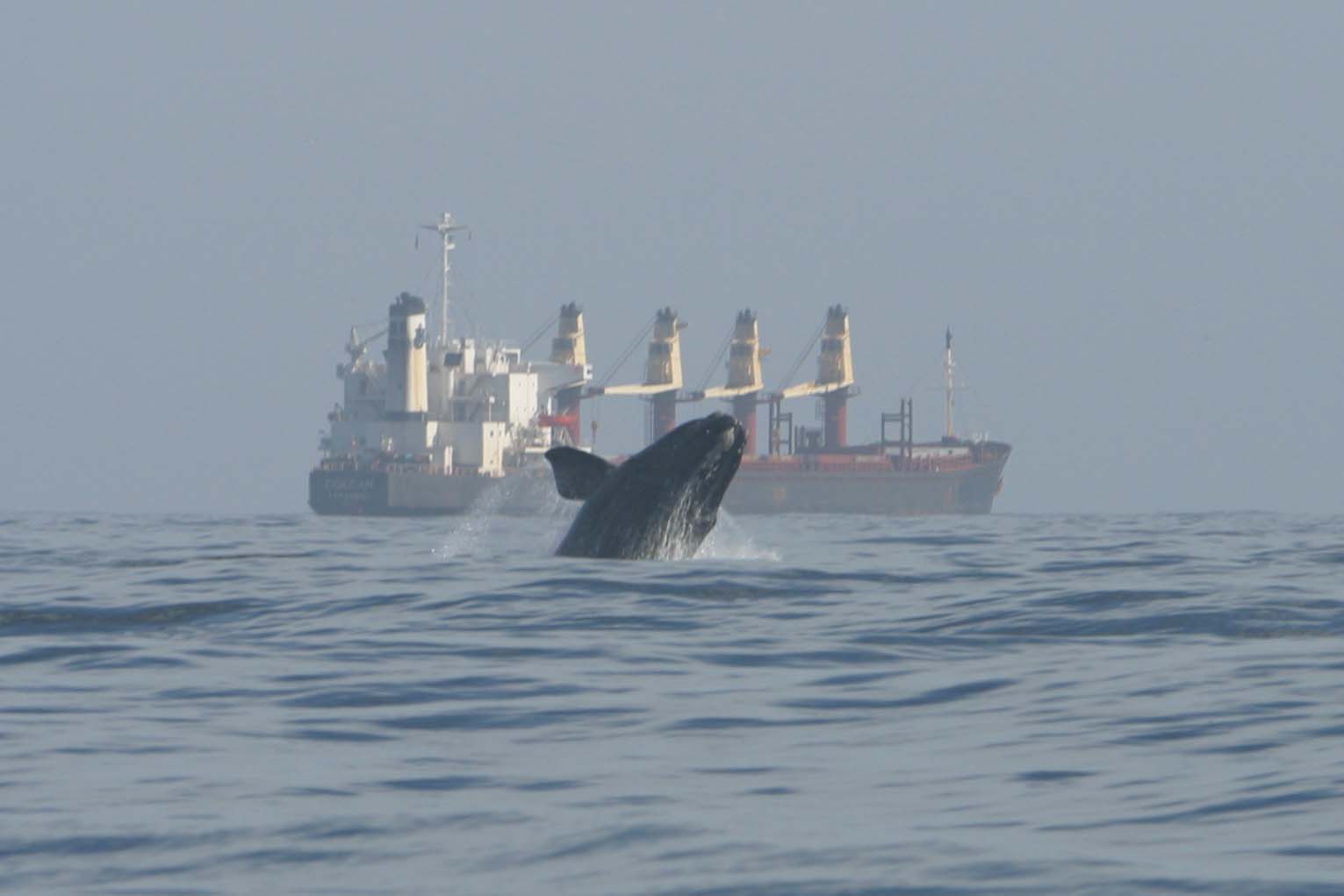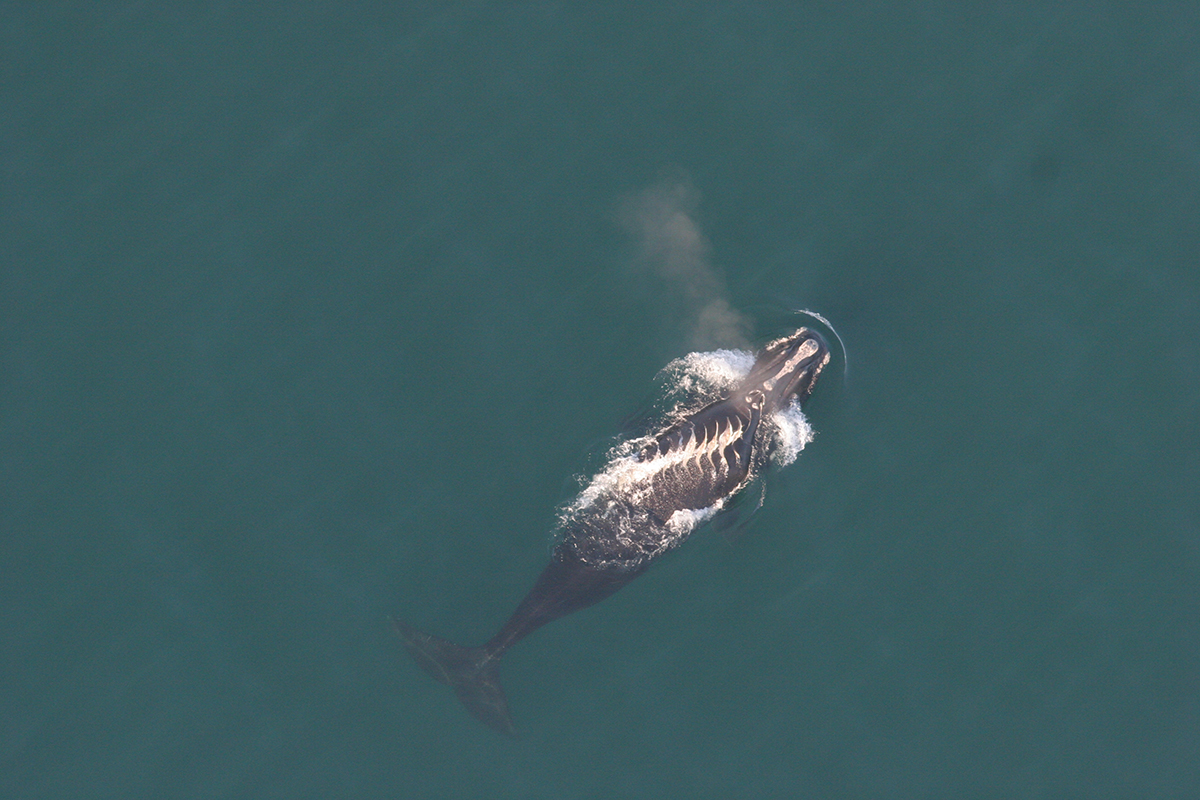
A new report from an ocean conservation advocacy organization finds that most ships are exceeding speed limits in areas federally designated to protect critically endangered North Atlantic right whales, with some of the worst compliance measured off the southern North Carolina coast, south to Georgia.
Oceana said it analyzed vessel speeds from 2017 to 2020 in speed zones established by the National Oceanic and Atmospheric Administration off the East Coast and found that only about 10% of vessels complied with mandatory speed zones and only about 15% cooperated in voluntary areas. The findings show the need for the federal government to update vessel speed requirements and expand enforcement, the group said.
Supporter Spotlight
Collisions with vessels and entanglement in fishing gear are the two leading causes of injury and death for North Atlantic right whales, of which only about 360 remain.
The worst compliance with speed restrictions was in the zone between Wilmington and Brunswick, Georgia, where an average of 87.5% of vessels violated the mandatory 10-knot speed limit. The zone is part of one of two areas designated as critical habitat for right whales. The area, with calving and nursing grounds from November to April, extends to south of Cape Canaveral, Florida.
Oceana said its analysis focused on vessels 65 feet or larger that are required to use public tracking devices, but any vessel can cause fatal injuries to right whales. The group said a calf died earlier this year from wounds from a collision with a 54-foot recreational fishing vessel off the Florida coast.
“Vessels are speeding, North Atlantic right whales are dying, and there’s not enough accountability,” said Whitney Webber, campaign director at Oceana, in a statement.
North Atlantic right whales were hunted until the practice was banned in 1935 after their numbers diminished from an estimated 21,000 to possibly fewer than 100 by the 1920s. Although the whaling ban allowed some recovery, Oceana said only about 360 remain.
Supporter Spotlight
The slow-moving whales – they swim at about 6 mph – can be hard to spot and unable to move out of the way of fast-moving ships. Oceana said that collisions with vessels are one of the leading causes of North right whale injuries and deaths.
NOAA’s two management tools to help protect right whales from vessel strikes are permanently designated mandatory seasonal management area speed zones in places where whales are expected to be, and reactive, voluntary dynamic management area speed zones when a whale is spotted.
“Oceana’s analysis shows that speeding vessels are rampant throughout North Atlantic right whales’ migration route, all along the East Coast, and in both mandatory and voluntary speed zones. North Atlantic right whales are dying from vessel strikes and NOAA must take action to prevent this,” Webber said. “Killing even one is a problem, as scientists estimate that even a single human-caused North Atlantic right whale death a year threatens the species’ chances of recovery. If NOAA is serious about its mandate to save North Atlantic right whales from extinction, speed zones must be designated in the areas where whales currently are, and they must be enforced. Until speed zone rules are mandatory and violators held accountable, North Atlantic right whales will continue to die on NOAA’s watch.”
Oceana said that it is urging NOAA to immediately revise vessel speed regulations to expand and establish new seasonal areas, make compliance with dynamic areas mandatory, expand speed requirements to include vessels under 65 feet in length and require vessels to continuously broadcast public tracking signals. Oceana is also calling on NOAA to improve compliance and enforcement of mandatory speed limits and narrow the exemption for federal agencies.

Kate Brogan, acting director, NOAA Fisheries Public Affairs, said Tuesday that the agency was aware of the Oceana report and its findings. She said the recommendations of the Oceana report largely agree with those published in NOAA Fisheries’ 2020 North Atlantic Right Whale Vessel Speed Rule Assessment.
“NOAA Fisheries is currently reviewing the public comments received on its 2020 assessment, which the agency will consider, along with the findings of Oceana’s report, as we evaluate additional options to further reduce vessel strikes of North Atlantic right whales,” Brogan said in an email response to Coastal Review.
The NOAA Office of Law Enforcement and NOAA Office of General Counsel have primary responsibility for enforcement of the vessel speed rule. The Office of Law Enforcement is supported by U.S. Coast Guard, which works in collaboration with NOAA Fisheries to assist with mariner compliance of federal regulations.
Enforcement actions include notices of violation and assessments of administrative penalty, referred to as NOVAs, and written warnings to vessels found to have exceeded the 10-knot speed limit in seasonal management areas. Civil penalties are assessed commensurate with the charges and are most often issued in cases where a vessel operator has shown substantial or repeated failure to comply with the speed rule.
Secondly, compliance assistance letters are sent to mariners found to have exceeded the 10-knot speed limit in less severe cases “to educate mariners on the requirements
of the speed rule and potential enforcement actions if the alleged conduct continues in
the future,” according to the 2020 assessment.
Thirdly, the Coast Guard hails vessel operators found transiting in excess of 10 knots in active seasonal management areas. Mariners are reminded of the speed rule and informed that they should reduce their speed accordingly. Vessel compliance with hail instructions is noted and reported to NOAA Fisheries.
The 2020 assessment notes than in recent years, 2017-2019, NOAA General Counsel, NOAA Office of Law Enforcement, and the Coast Guard have had a total of 178 enforcement-related contacts via the three avenues. The total includes 60 contacts in 2017, 54 in 2018 and 64 in 2019.
Since most vessels transit repeatedly through seasonal management areas, one enforcement contact may cover numerous transits in possible violation of the speed rule. Vessel operators are given a chance to provide evidence that their excess speed was for safety reasons.
Oceana analyzed vessel compliance with speed restrictions in both types of area between 2017 and 2020 using data from Global Fishing Watch, an international nonprofit organization founded by Oceana in partnership with Google and SkyTruth. Oceana said it analyzed self-reported vessel speeds and location data to track vessel speeds and positions in North Atlantic right whale conservation areas.
More than 80% of the vessels violated the speed limit between Cape May, New Jersey, to Florida, and the southern states’ dynamic management areas had the highest rate of noncooperation, Oceana said. But the high volume of traffic in the Southern New England management area poses the greatest threat to right whales despite having a lower percentage of noncooperation than others, Oceana said.
The group said that cargo ships were the least compliant vessel type in both dynamic and seasonal management areas. Two-thirds of the vessels that exceeded the 10-knot speed limits operated under foreign flags, but the worst offenders were flagged to the U.S., Panama, Marshall Islands, Liberia, Germany and Singapore.









